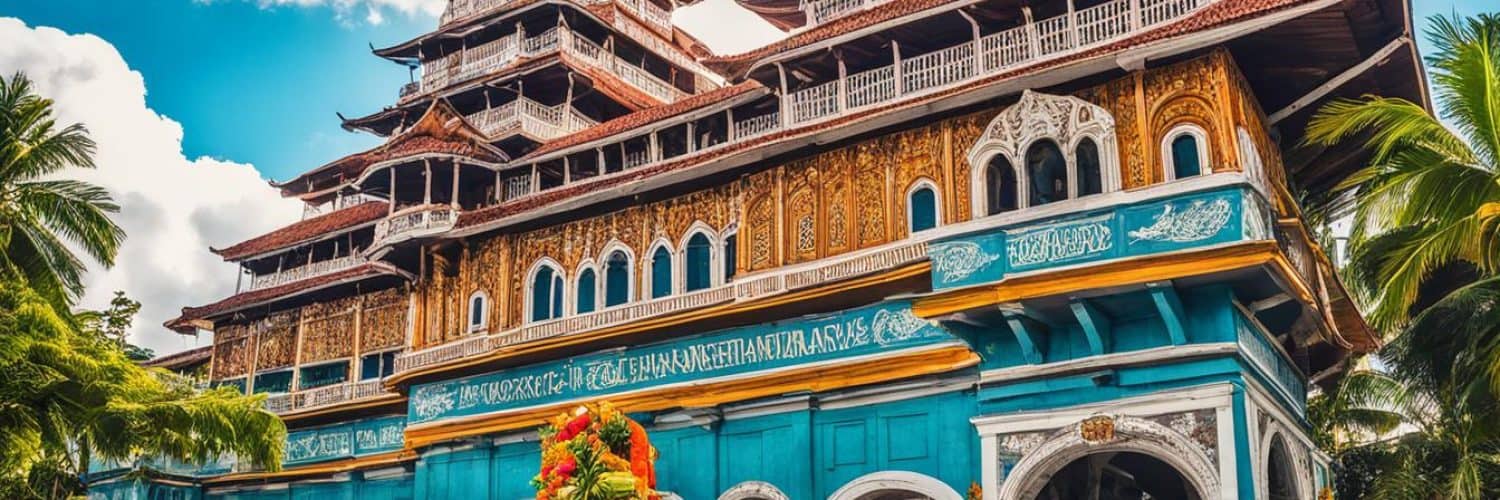Did you know that deep within the rich tapestry of Philippine history lies the fascinating story of the ancient Rajahnate of Cebu? This pre-colonial kingdom, with its historical significance and thriving civilization, played a crucial role in shaping Cebuano culture and Philippine history as a whole.
The Rajahnate of Cebu, ruled by indigenous leaders known as Rajahs, stood as a testament to the ingenuity and resilience of an ancient civilization. Its well-established trade networks attracted explorers from afar, including the renowned Ferdinand Magellan.
As we delve into the annals of time, uncover the secrets of indigenous governance and witness the enduring legacy of the Rajahnate of Cebu. Immerse yourself in the vibrant history, culture, and influence of this ancient kingdom.
Key Takeaways:
- The Rajahnate of Cebu was an ancient kingdom in the Philippines with historical significance.
- It thrived during the pre-colonial era and was ruled by indigenous leaders known as Rajahs.
- The kingdom had well-established trade networks and was visited by explorers like Ferdinand Magellan.
- The Rajahnate of Cebu left a lasting legacy on Cebuano culture and the history of the Philippines.
- Join us as we explore the intriguing history, myths, and enduring influence of this ancient civilization.
The Origins of Cebu – Legends and Myth
According to legends and myths, the ancient name of Cebu, known as “Sugbo,” originated from the story of a town that was burned down to drive away sea pirates. The inhabitants of Sugbo would seek refuge in the mountains and launch a counter-offensive against the invaders. This story reflects the rich culture and history of pre-colonial Cebu and its connection to a powerful Hindu empire. The legends and myths of Cebu provide insight into the ancient civilization and the origins of the Rajahnate of Cebu.
Legends and Myths of Cebuano Culture
The legends and myths passed down through generations have played a crucial role in preserving the cultural heritage of Cebuano society. These stories provide a glimpse into the beliefs, traditions, and values of the people who inhabited the region in ancient times. They offer a fascinating narrative of the origins of Cebu and the Rajahnate of Cebu, shedding light on the historical and mythical aspects of the ancient civilization.
In the legends, the story of Sugbo’s burning and subsequent rise from the ashes symbolizes the strength and resilience of the Cebuano people. It reflects their determination to protect their land and their unwavering spirit in the face of adversity.
Cebuano culture is deeply rooted in folklore, with mythical figures and tales forming an integral part of the region’s identity. These legends often intertwine with historical events, blurring the line between reality and myth. They offer a unique perspective on the ancient civilization that thrived in Cebu, showcasing the cultural richness and diversity of the region.
Uncovering the Ancient Civilization
The legends and myths of Cebu provide valuable insights into the origins and development of the Rajahnate of Cebu. They offer glimpses into the political, social, and economic structure of the ancient civilization, revealing the intricate web of beliefs and practices that shaped the Cebuano culture.
One of the key elements in these legends is the connection between Cebu and the powerful Hindu empire. The stories often depict a time when the region was influenced by Hindu culture and governance, showcasing the cosmopolitan nature of Cebu’s ancient society.
Exploring these legends and myths not only adds depth and intrigue to the history of Cebu but also highlights the significance of the ancient civilization and its enduring impact on modern Cebuano culture. It is through these stories that the legacy of the Rajahnate of Cebu lives on, captivating the imagination and fostering a sense of pride among the Cebuano people.
Sri Lumay and the Chola Dynasty Link
Sri Lumay, the founder of the Rajahnate of Cebu, has a fascinating connection to the Chola dynasty, a Tamil dynasty from South India.
According to historical accounts, Sri Lumay was believed to be a prince from the Chola dynasty, sent to the Philippines by the ruling maharajah to establish a forward base for expeditionary forces. However, instead of fulfilling his intended purpose, Sri Lumay rebelled against the Chola dynasty and established his independent Rajahnate in Cebu.
This link to the Chola dynasty adds an intriguing layer to the story of the Rajahnate of Cebu and demonstrates the historical connections between South India and the Philippines during the ancient civilization era.
“Sri Lumay’s rebellion against the Chola dynasty and the subsequent establishment of his own kingdom in Cebu showcases his determination and leadership qualities. His actions marked the birth of the Rajahnate of Cebu and set the stage for its cultural and historical significance.”
The Chola Dynasty: Ancient South Indian Powerhouse
The Chola dynasty, known for its influence in South India, played a pivotal role in the region’s history and culture. With their strong maritime trade networks and military prowess, the Cholas expanded their empire and established powerful connections with Southeast Asian kingdoms, including the Rajahnate of Cebu.
It is through the daring rebellion of Sri Lumay that the link between the Chola dynasty and the Rajahnate of Cebu is forged, creating an enduring historical legacy of cultural exchange and influence between South India and the Philippines.
| Chola Dynasty | Rajahnate of Cebu |
|---|---|
| South Indian empire | Ancient kingdom in the Philippines |
| Known for maritime trade and military power | Established trade networks and diplomatic relations |
| Expanded empire and influenced Southeast Asia | Renowned for its cultural and historical significance |
The Legacy of Sri Lumay
Sri Lumay, the founder of the Rajahnate of Cebu, left behind a lasting legacy that resonates in contemporary Cebuano society. As the ruler of this ancient kingdom, Sri Lumay played a crucial role in the cultural, political, and economic development of Cebu. His contributions have left an indelible mark on the history and identity of this region.
Under Sri Lumay’s leadership, the Rajahnate of Cebu thrived as an ancient kingdom. The cultural heritage and traditions established during his reign continue to be celebrated and cherished in present-day Cebuano culture. Sri Lumay’s profound impact can be felt in various aspects of Cebu’s society, from its customs and traditions to its artistic expressions and religious practices.
One significant aspect of Sri Lumay’s legacy is the preservation of the Rajahnate of Cebu as a cultural heritage site. Today, visitors can explore historical landmarks and archaeological sites that bear witness to the ancient kingdom’s rich past. These sites serve as a tangible reminder of Sri Lumay’s influence and the enduring significance of the Rajahnate of Cebu in Philippine history.
“Sri Lumay’s vision and leadership laid the foundation for the Rajahnate of Cebu, and his legacy continues to inspire generations. The cultural heritage he established serves as a bridge between the past and the present, connecting us to our roots and reminding us of the strength and resilience of the Cebuano people.” – Local historian
Furthermore, Sri Lumay’s contributions to governance and administration set a standard for future rulers. His emphasis on maintaining law and order, protecting the people, and promoting economic development established a legacy of effective governance that shaped subsequent Cebuano rulers. Sri Lumay’s commitment to good governance laid the groundwork for the success and growth of the Rajahnate of Cebu throughout its history.
The legacy of Sri Lumay extends beyond historical narratives and oral traditions. It lives on in the hearts of the Cebuano people, who continue to honor their ancient roots and cultural heritage. The values and traditions passed down from generation to generation bear the imprint of Sri Lumay’s reign, reflecting his profound influence on Cebuano society.
| Legacy of Sri Lumay | Impacts |
|---|---|
| Preservation of Cultural Heritage | Historical landmarks and archaeological sites |
| Standard for Governance | Effective administration and governance practices |
| Celebration of Cebuano Culture | Continued emphasis on customs, traditions, and arts |
Aginid Epic – Preserving History Through Oral Tradition
The Aginid epic holds a significant place in Visayan culture, serving as a valuable repository of historical narratives from the reign of Sri Lumay. Passed down through generations, this oral tradition immortalizes the events and achievements that shaped the Rajahnate of Cebu. The Aginid epic vividly portrays the battles, political intrigues, and cultural transformations that unfolded during this era, offering invaluable insights into the ancient Visayan civilization.
This epic serves as a testament to the enduring influence of Sri Lumay, the founder of the Rajahnate of Cebu, and his significance in the cultural fabric of the Visayan region. The Aginid epic not only encapsulates the historical events but also preserves the traditions and values of the Visayan people, emphasizing the importance of oral tradition in documenting and safeguarding cultural heritage.
“The Aginid epic is a remarkable narrative that weaves together the threads of history, showcasing the bravery, wisdom, and resilience of our ancestors. It is through this oral tradition that we honor and celebrate the legacy of Sri Lumay and his impact on the Visayan culture.”
The Aginid epic transcends mere storytelling; it is a living testament to the history of the Visayan people. The power and significance of this oral tradition lie in its ability to capture the essence of a bygone era, transporting listeners to a time when Sri Lumay’s leadership and the Rajahnate of Cebu flourished. Through the Aginid epic, the Visayan people connect with their roots, preserving and perpetuating their rich historical heritage for generations to come.
Key Characters of the Aginid Epic:
- Sri Lumay – The legendary founder of the Rajahnate of Cebu
- Rajahs – Indigenous leaders who ruled the Rajahnate of Cebu
- Warriors and Heroes – Figures who played crucial roles in battles and leadership
The Aginid epic embodies the resilience, courage, and cultural pride of the Visayan people, serving as a reminder of their glorious past and an inspiration for the present and future generations.

Comparative Analysis of Key Events in the Aginid Epic
| Key Events | Sri Lumay’s Reign | Visayan Culture | Historical Narratives |
|---|---|---|---|
| Battles | Multiple epic battles, characterized by strategic brilliance | Emphasis on bravery, honor, and warrior traditions | Depiction of triumphs, the struggle for independence, and defense of the Rajahnate |
| Political Intrigues | Intricately woven webs of power struggles and alliances | Highlighting the complexity and nuances of ancient governance | Revealing the intricacies of court politics and leadership struggles |
| Cultural Transformations | Integration of diverse cultural influences, arts, and traditions | Reflection of the fusion of indigenous, Indian, and Southeast Asian cultures | Documenting the evolution of Visayan culture and societal norms |
The Aginid epic serves as an invaluable resource for scholars and enthusiasts alike, offering a glimpse into the Rajahnate of Cebu’s grandeur, the richness of Visayan culture, and the compelling historical narratives that continue to shape the Philippine archipelago.
Geopolitical Influence of the Rajahnate of Cebu
The Rajahnate of Cebu, an ancient kingdom in Southeast Asia, held significant geopolitical influence during its time. As a regional power, the Rajahnate actively controlled vital trade networks and established diplomatic relations with neighboring polities.
By dominating key trade routes, the Rajahnate of Cebu facilitated the flow of goods and resources throughout the region. This allowed for economic growth and prosperity, benefiting both the kingdom and its trading partners.
Furthermore, the Rajahnate’s diplomatic efforts solidified its position as a respected regional power. The establishment of alliances and friendly relations with neighboring polities fostered political stability and security in Southeast Asia.
“The Rajahnate of Cebu’s strategic control over trade networks and its successful diplomacy made it a prominent player in the region.”
The kingdom’s ability to navigate complex diplomatic landscapes contributed to the overall stability of Southeast Asia. It played a crucial role in fostering peace and cooperation among neighboring polities, strengthening regional ties.
As shown in the visual above, the Rajahnate of Cebu’s control of trade networks and its regional power status were instrumental in shaping the economic and political landscape of Southeast Asia during that era.
In conclusion, the Rajahnate of Cebu’s geopolitical influence stemmed from its control of trade networks and its adept diplomacy. As a regional power, the kingdom played a vital role in facilitating trade, fostering economic growth, and ensuring political stability in Southeast Asia.
Battle Tactics of Sri Lumay Against Moro Raiders
Sri Lumay, the renowned leader of the Rajahnate of Cebu, was faced with the constant threat of Moro raiders from Mindanao. In order to safeguard his kingdom and protect his people, Sri Lumay devised a series of ingenious battle tactics and defense strategies.
One of Sri Lumay’s most notable strategies was the implementation of scorched earth policies. Recognizing that the Moro raiders relied heavily on pillaging and looting local towns and harvesting crops, Sri Lumay devised a plan to deprive them of valuable resources. His strategy involved systematically burning down towns and destroying crops, rendering the raided areas barren and unsuitable for sustaining the raiders.
“We must starve the Moro raiders of the spoils they seek,” Sri Lumay declared. “By leaving nothing for them to take, we weaken their ability to sustain their attacks.”
This approach earned Sri Lumay the nickname “Kang Sri Lumayang Sugbu,” a testament to his military prowess and innovative strategies. Through his astute leadership, the Rajahnate of Cebu was able to effectively defend against the Moro raiders and maintain the safety and security of its people.
Moreover, Sri Lumay’s emphasis on military preparedness and the training of his troops played a significant role in the defense of the Rajahnate. He employed skilled tactics such as establishing lookout posts and deploying soldiers strategically to prevent surprise attacks. These defense strategies ensured that the kingdom was always ready to repel any invasion and maintain control over its territories.
In addition to his military acumen, Sri Lumay also recognized the importance of alliances and diplomatic relations in protecting the Rajahnate of Cebu. He forged partnerships with neighboring polities and established a network of allies, further strengthening the defenses of his kingdom.
The battle tactics and defense strategies employed by Sri Lumay against the Moro raiders showcased his innovative thinking and commitment to protecting his people. His military prowess and strategic vision were instrumental in ensuring the safety and stability of the Rajahnate of Cebu during a time of constant threats and challenges.
Successors of Sri Lumay and Continuation of Legacy
After the passing of Sri Lumay, his son Sri Bantug ascended the throne, ushering in a seamless transition of power within the Rajahnate of Cebu. Building upon his father’s legacy, Sri Bantug continued the administration and governance of the kingdom, ensuring the preservation of their ancestral heritage.
Rajah Humabon, the son of Sri Bantug, played a pivotal role in the post-Sri Lumay era. As an eyewitness to significant historical events, including the fall of Singhapala, the capital city, Rajah Humabon contributed to shaping the destiny of the Rajahnate of Cebu.
“The successors of Sri Lumay not only carried on his vision but also made their mark on the rich history and cultural heritage of Cebu. They upheld the values and traditions instilled by Sri Lumay, ensuring the continued prosperity and prominence of the Rajahnate of Cebu,”
Under their leadership, the successors of Sri Lumay exemplified the enduring spirit of the Cebuano rulers, leaving behind a lasting legacy that influenced the development and identity of the region.
Successors of Sri Lumay
| Name | Reign |
|---|---|
| Sri Bantug | Unknown |
| Rajah Humabon | 1521-1571 |
The table above illustrates the reign of the successors of Sri Lumay, highlighting the crucial role they played in carrying forward their father’s legacy and continuing the history of the Rajahnate of Cebu.
Administration and Governance Under Sri Lumay
Sri Lumay, the visionary founder of the Rajahnate of Cebu, established a well-structured administration and governance system that laid the foundation for the kingdom’s success. Sri Lumay’s leadership and effective governance practices were focused on several key aspects, including maintaining law and order, protecting the welfare of the people, and driving economic development.
Central to Sri Lumay’s administration was the establishment of a robust legal framework that ensured a just and fair society. Laws were implemented to safeguard the rights of the people and maintain social harmony within the kingdom. Sri Lumay’s commitment to upholding justice and order created a stable environment in which the Cebuano people could thrive.
In Sri Lumay’s quest for progress and prosperity, he recognized the importance of economic growth and facilitated trade and commerce within the region. Through the establishment of trade networks and strategic partnerships, Sri Lumay stimulated economic activity, creating opportunities for entrepreneurship and contributing to the overall prosperity of the Cebu kingdom.
“Our vision for the Rajahnate of Cebu is rooted in the wellbeing of our people, the rule of law, and economic prosperity. By fostering a favorable environment for trade and commerce, we can unlock the potential within our kingdom and create a better future for all.” – Sri Lumay
The success of Sri Lumay’s governance can be seen in the enduring legacy of the Cebu kingdom. His commitment to good governance and administration set the stage for the growth and achievements of subsequent rulers, ensuring the continuity of a strong and prosperous kingdom.
Table: Achievements of Sri Lumay’s Administration
| Administration and Governance | Key Achievements |
|---|---|
| Maintaining Law and Order | Establishment of a robust legal framework, ensuring justice and social harmony |
| Protection of the People | Implementation of policies to safeguard the welfare and rights of the Cebuano people |
| Promoting Economic Development | Facilitation of trade and commerce, stimulating economic growth and prosperity |
Through Sri Lumay’s visionary leadership and effective governance, the Rajahnate of Cebu flourished and left a profound impact on the history and culture of the region. Sri Lumay’s legacy continues to inspire and shape the principles of administration and governance in modern-day Cebu.
Economic Transformation During Sri Lumay’s Reign
Sri Lumay’s reign marked a turning point in the economic landscape of the Rajahnate of Cebu. His visionary leadership ushered in a remarkable period of economic transformation, propelling the kingdom into a vibrant center of trade and commerce.
Under Sri Lumay’s rule, the Cebu kingdom became a sought-after destination for merchants from various regions such as China, Japan, and India. Trade relations were established, and a flourishing exchange of goods and commodities took place, stimulating economic growth and prosperity.
“The economic achievements during Sri Lumay’s reign laid the foundation for Cebu’s status as a thriving hub of commerce and trade.”
The strategic location of Cebu, combined with Sri Lumay’s progressive policies, fostered a conducive environment for business and trade. The kingdom’s ports bustled with activity as merchants from different parts of the world brought their goods to be bought, sold, and exchanged.
The economic transformation under Sri Lumay’s leadership not only brought wealth and prosperity to the Rajahnate but also had a ripple effect on the surrounding regions. The kingdom’s thriving economy fueled the growth of neighboring communities, stimulating development and facilitating cultural exchange.
The Benefits of Trade Relations and Commerce
The establishment of trade relations with other nations opened up avenues for the exchange of new ideas, technologies, and cultural practices. This cross-pollination of knowledge fuelled innovation and stimulated societal progress within the Rajahnate of Cebu.
Furthermore, the economic prosperity brought about by the trade networks fostered an environment of stability and security within the kingdom. The resources generated from trade allowed Sri Lumay to invest in the expansion of infrastructure, fortifications, and the protection of his people.
Enhancing the Cebu Kingdom’s Influence
The economic transformation during Sri Lumay’s reign strengthened the Cebu kingdom’s influence within the region. As a prosperous trading hub, the Rajahnate of Cebu became an attractive partner for neighboring polities, fostering diplomatic relations and alliances.
The economic growth of the kingdom enhanced Sri Lumay’s authority and bolstered the stability of his reign. The wealth generated from trade provided the necessary resources to maintain a formidable military that could defend against external threats.
The Long-lasting Impact
The economic transformation witnessed during Sri Lumay’s reign established a solid foundation for the future growth and success of the Cebu kingdom. The prosperity and commercial vibrancy that emerged from his visionary policies resonated throughout the centuries, shaping Cebu’s identity as a thriving center of commerce and trade.
The legacy of Sri Lumay’s economic transformation continues to influence Cebu’s modern business landscape, embracing its rich history as a testament to its enduring relevance in the contemporary world.
The Arrival of European Explorers
The arrival of European explorers in the Rajahnate of Cebu marked a significant turning point in history. One notable explorer was Ferdinand Magellan, whose expedition to the Philippines brought European influence to the region. This historic event initiated contact between the indigenous people and the outside world, ushering in a new era of cultural exchange and trade opportunities.
During Magellan’s journey, he encountered Lapu-Lapu, a native king from Mactan Island. This encounter led to the famous Battle of Mactan, which would shape the course of Philippine history. The conflict between Magellan and Lapu-Lapu highlighted the resistance of the indigenous people against foreign forces and marked the beginning of European colonization in the Philippines.
“The encounter between Magellan and Lapu-Lapu demonstrated the indomitable spirit of the Filipinos in defending their homeland. It serves as a reminder of the courage and resilience of the indigenous people of Cebu.”
The arrival of European explorers also opened up new trade routes and opportunities for the Rajahnate of Cebu. Europeans brought with them advanced sailing technology and sought to establish trade partnerships with local kingdoms. This led to the expansion of trade networks and the introduction of new goods and ideas to the region.
European Explorers and the Development of Trade Routes
| Explorer | Impact on Trade Routes |
|---|---|
| Ferdinand Magellan | Initiated contact between Europe and the Philippines, paving the way for future trade |
| Antonio Pigafetta (Magellan’s Chronicler) | Documented trade routes and valuable information about the Philippines |
| Miguel López de Legazpi | Established the Spanish trading post in Cebu, facilitating trade between Europe and Asia |
| Sebastian Elcano | Completed Magellan’s circumnavigation, further expanding trade possibilities |
The arrival of European explorers brought both opportunities and challenges for the Rajahnate of Cebu. While trade routes expanded and exposed local kingdoms to new ideas, the colonization that followed also brought significant changes in governance and culture. Nevertheless, the encounter between European explorers and the indigenous people of Cebu played a vital role in shaping the history and identity of the region.
The Spanish Colonial Period
After Magellan’s expedition, Cebu and the Philippines fell under the rule of the Spanish empire. The arrival of the Spanish colonizers marked a significant turning point in Philippine history. As a result of Spanish colonization, Cebu’s culture, governance, and heritage underwent profound transformations.
The Spanish influence left a lasting impact on Cebu and the Philippines as a whole. The colonizers established their presence and implemented their own systems and structures of governance. Spanish influences can still be seen in the architecture, language, religion, and traditions of Cebu.
During the Spanish colonial period, the Philippines became a part of the vast Spanish empire, known as the Spanish East Indies. The Spaniards introduced Christianity as the dominant religion and converted many Filipinos to Catholicism. They built beautiful churches, such as the Basilica Minore del Santo Niño, a significant spiritual landmark in Cebu.
The Spanish colonial period witnessed a fusion of Spanish and indigenous cultures, resulting in a unique blend that characterizes Filipino culture to this day.
The Spanish colonizers also introduced new crops and agricultural techniques, leading to advancements in farming and trade. The galleon trade, which connected the Philippines to Mexico and other parts of the world, flourished under Spanish rule. This trade route fostered cultural exchange and economic growth, making Cebu a vital hub of commerce in the region.
However, Spanish colonization was not without its challenges and controversies. The indigenous population faced forced labor, land seizures, and cultural assimilation. The Spanish authorities imposed their language, traditions, and social hierarchy, resulting in the suppression of indigenous cultures and traditions.
Despite these difficulties, Spanish influence played a significant role in shaping the history and identity of Cebu. It laid the foundations for the development of Philippine society and contributed to the rich cultural tapestry of the country.
Spanish Colonial Period Highlights:
- The introduction of Christianity and the establishment of Catholicism as the dominant religion.
- The construction of magnificent churches and religious landmarks.
- The fusion of Spanish and indigenous cultures, leading to a distinct Filipino identity.
- The expansion of trade networks, including the galleon trade, which stimulated economic growth.
- The imposition of Spanish language, governance, and social hierarchy.
- The suppression and assimilation of indigenous cultures and traditions.
The Spanish colonial period played a crucial role in shaping the history and culture of Cebu and the Philippines. It left a lasting legacy that can still be felt today, making it an important chapter in Philippine history.
Cebu’s Journey Through American and Japanese Occupations
In the early 20th century, Cebu experienced a significant period of transformation and change as it went through both American colonial rule and Japanese occupation, two defining chapters in Philippine history.
Following the Spanish-American War, the Philippines was ceded to the United States. This marked the beginning of the American colonial period in Cebu and the rest of the country. Under American rule, Cebu underwent political changes and modernization efforts. The introduction of new infrastructure, education systems, and governance structures brought both opportunities and challenges to the people of Cebu.
However, the course of history took a dramatic turn during World War II. In 1942, Cebu fell under Japanese occupation, and the island became a strategic base for the Japanese military. The Japanese forces exerted control over the region and imposed their authority on the local population.
The Japanese occupation was a period of immense hardship for the people of Cebu. The occupation brought about widespread suffering, with atrocities committed by the Japanese forces. The local population faced great challenges as they struggled to survive under the oppressive regime.
Despite the challenges faced during this time, the people of Cebu displayed resilience and strength, coming together to resist and endure the occupation.

After a long and arduous period, the occupation eventually came to an end with the liberation of Cebu by American and Filipino forces. This marked a turning point in Cebu’s history, as the island began the process of rebuilding and recovering from the devastation of war.
The American and Japanese occupations of Cebu left a lasting impact on the island’s culture, society, and collective memory. They serve as reminders of the struggles endured and the resilience exhibited by the people of Cebu during tumultuous times in Philippine history.
The Impact of American Colonial Rule
The American colonial period brought about significant political changes and modernization efforts in Cebu. The introduction of new systems of governance, education, and infrastructure had a lasting impact on the island’s development. Cebu became an important hub for trade and commerce, thanks to the modernization campaigns initiated by the American administration.
The Challenges of Japanese Occupation
The Japanese occupation of Cebu was a dark chapter in the island’s history. The occupation brought widespread suffering, with the local population subjected to forced labor, arbitrary executions, and other forms of oppression. The people of Cebu faced numerous challenges as they struggled to survive and resist the Japanese forces.
The Legacy of American and Japanese Occupations
The experiences of Cebu under both American colonial rule and Japanese occupation are integral parts of the island’s history and heritage. They have shaped the collective memory and resilience of the Cebuano people, reminding them of the importance of freedom, independence, and the pursuit of a better future.
| Key Events | American Colonial Period | Japanese Occupation |
|---|---|---|
| Period | 1898-1946 | 1942-1945 |
| Political Changes | Introduction of new governance systems | Imposition of Japanese authority |
| Economic Impact | Modernization efforts, trade expansion | Resource exploitation, economic hardship |
| Challenges Faced | Resistance to foreign rule | Survival under oppressive regime |
| Legacy | Modern institutions, lasting cultural influence | Resilience, collective memory |
Conclusion
The ancient Rajahnate of Cebu, with its historical significance, played a pivotal role in shaping Philippine history. This vibrant center of culture, trade, and governance left behind a lasting legacy. The founder of the Rajahnate, Sri Lumay, continues to be celebrated in contemporary Cebuano society, showcasing the deep connection to the past.
The rich heritage and cultural traditions established during this era have significantly influenced the identity of the Cebuano people. The enduring influence of the Rajahnate of Cebu illustrates the contributions of ancient civilizations to the history and culture of the Philippines.
The Rajahnate of Cebu stands as a testament to the remarkable achievements of the past, leaving an indelible mark on Cebuano culture and the collective memory of the Philippines. Its legacy serves as a reminder of the historical significance and the enduring spirit of the people.


















Add comment